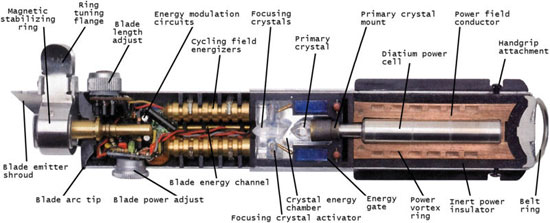GE Engineer Explains How Lightsabers Work...or not

Ever wonder how a lightsaber from Star Wars could work? Well, I hate to break it to you but it can't. GE engineer Matt Gluesnkamp went through and analyzed the technology it would take to actually make a working lightsaber, unfortunately he couldn't find a way to make it happen.
So is what here is what he came up with.
In the Star Wars universe, lightsabers are typically custom-built by Jedi and Sith warriors, but all have several common elements. Each has a power source, a lightsaber crystal, one or more focusing crystals, and a stabilizing emitter system. The power source is typically a diatium power cell, often with a capacity of several megawatt-hours. The lightsaber crystal converts the power cell’s energy into a plasma that is then passed through and directed by the focusing crystals. Finally, the emitter system stabilizes the plasma into a blade shape using a mix of power modulation and magnetic field containment.
The first problem... the battery.
Although real-life battery technology is coming along great. We are a long way off from creating handheld batteries with capacities like that the ones found in the lightsaber's diatium power cell.
Of course Jedi's don't need to worry about batteries because they have diatium which is pretty much powered by the force. The next problem we run into... the blade, which Gluesenkamp calls "really convoluted."
There are also no crystals that can 'direct' a plasma. In fact, a plasma 'being directed' by a crystal lens doesn't make any physical sense anyway. A plasma is really just an ionized gas — a gas in which the electrons have been stripped from their atomic nuclei.
Wow, this guy sure knows how to ruin the fun of a lightsaber. But let say a powerful plasma beam could be created... how do you control it? You need something there to control the plasma's shape.
An electrical arc can have wild shifts in direction, and it can hardly be controlled without being surrounded by magnets. A laser will go in a straight line, but of course it doesn't stop. A laser-based lightsaber would require a block or a couple of mirrors floating in midair, moving in sync with the hilt — which is of course largely impossible.
Well, this sucks. My dreams of owning a real working lightsaber have been destroyed today thanks to a GE engineer. You know what? I'm sorry... but if this engineer can't create a working lightsaber, then he must not be a very good engineer. Get me someone that can build a lightsaber!